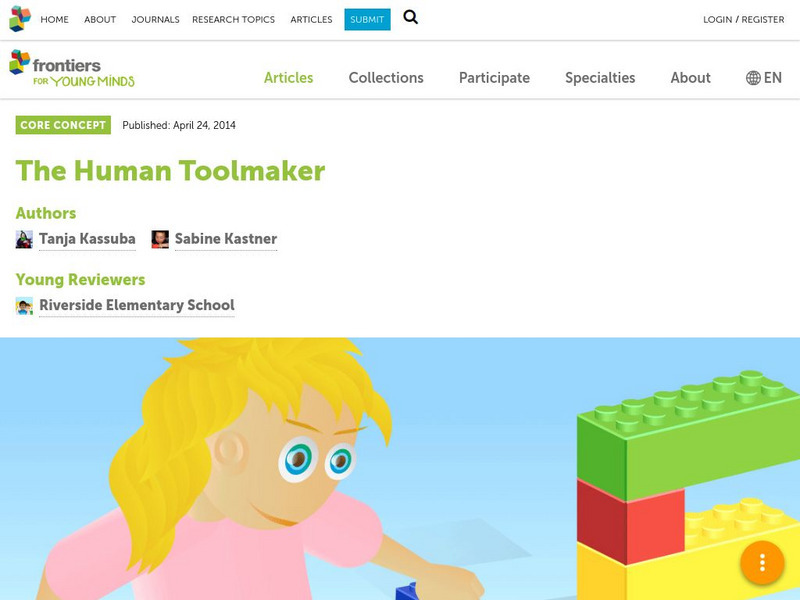TeachEngineering
Teach Engineering: Reflecting on Human Reflexes
Young scholars learn about human reflexes, how our bodies react to stimuli and how some body reactions and movements are controlled automatically, without thinking consciously about the movement or responses. In the associated activity,...
TeachEngineering
Teach Engineering: Are We Like Robots?
Students explore the similarities between how humans move and walk and how robots move, so they come to see the human body as a system from an engineering point-of-view. Movement results from decision making (deciding to walk and move)...
TeachEngineering
Teach Engineering: How Do Human Sensors Work?
This lesson highlights the similarities between human sensors and their engineering counterparts. Taking this approach enables students to view the human body as a system, that is, from the perspective of an engineer. Humans have...
TeachEngineering
Teach Engineering: What Is a Sensor?
Students gain a rigorous background in the primary human sensors, as preparation for comparing them to some electronic equivalents in the associated activity.
TeachEngineering
Teach Engineering: How Does a Sound Sensor Work?
Students learn about how sound sensors work, reinforcing their similarities to the human sense of hearing. This lesson and its associated activity enable students to appreciate how robots can take sensor input and use it to make...
TeachEngineering
Teach Engineering: How Does an Ultrasonic Sensor Work?
Students learn how ultrasonic sensors work, reinforcing the connection between this sensor and how humans, bats, and dolphins estimate distance.
TeachEngineering
Teach Engineering: The Claw
Students learn about gear ratios and power by operating toy mechanical cranes of differing gear ratios. They attempt to pick up objects with various masses to witness how much power must be applied to the system to oppose the force of...
TeachEngineering
Teach Engineering: Projectile Motion
Students are introduced to the concept of projectile motion, of which they are often familiar from life experiences,such as playing sports such as basketball or baseball, even though they may not understand the physics involved. Students...
Frontiers Media
Frontiers: Human Toolmaker
Do you enjoy building airplanes, cars, houses, or robots with Lego blocks? Humans are the only animal species that can create complicated constructions from simple Lego blocks - our Lego building ability is "human-specific," since it is...
Scientific American
Scientific American: Earthquake Proof Engineering for Skyscrapers
Learners construct a shake table, then build towers of different heights using Lego blocks, and test their stability on this platform. Next, they test towers with different sized bases, and towers made using different materials.
Common Sense Media
Common Sense Media: Education: Selling Stereotypes Grades 3 5
Students are introduced to the concept of a stereotype, and they explore the messages they receive regarding differences between boys and girls. They watch and discuss a video of a little girl questioning why companies market boys' and...
Other
The Digital Scoop: Using Skitch in Kindergarten
In this article, a teacher explains how she taught kindergarten students to take photographs. They were then shown how to open an iPad app called Skitch and add words to accompany their pictures. This was followed by a Math activity...
Other
Foundation for the Inspiration and Recognition of Science and Technology
The resource offers mentor-based programs that build science, engineering, and technology skills.
Museum of Science
The Museum of Science: Sketch Gadget Anatomy
The Museum of Science provides this site that shows the activity in which students sketch all the elements of a compound machine describing each component's function. Also includes an extension activity for homework.
Other
Playdough to Plato: First Grade Stem Activities
This blog contains challenging STEM activities you can use to build confidence and take your teaching to the next level. Included are science, math, technology, and engineering activities.
TeachEngineering
Teach Engineering: Design an Egyptian Playground
Students are broken up into four groups. Each group will use their knowledge about Egypt to originate a playground for Egyptian children. This will involve brainstorming ideas on paper, building a prototype with Legos or other material,...
Scholastic
Scholastic: Teaching Tools: Easy Ways to Have Fun Teaching Time Skills
This site discusses easy ways to have fun teaching time skills. These activities, games, and books will help your students master reading and measuring time.
Khan Academy
Khan Academy: Building Ant Bot
Learn how to build a robot that can mimic basic ant walking & running behavior.
Other
League of Nations: 1920 1946 Map
A color-coded map from Matthew White's Homepage showing which countries were a part of the League of Nations during specific times in history.
Other popular searches
- Lego Simple Machines
- Lego Construction
- Pulley Lego Simple Machines
- Lego Robotics
- Inclined Plane Lego
- Lego Math
- Lego Robolab
- Lego Building
- Weather Instruments Lego
- Lego Robots
- Legos Compound Machines
- Lego Lessons


















